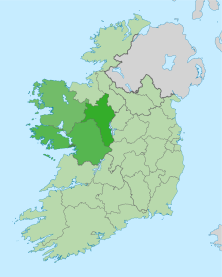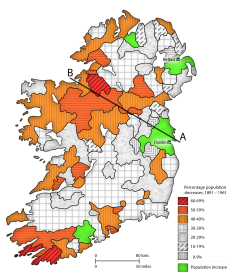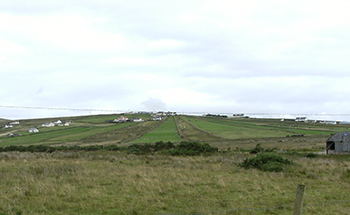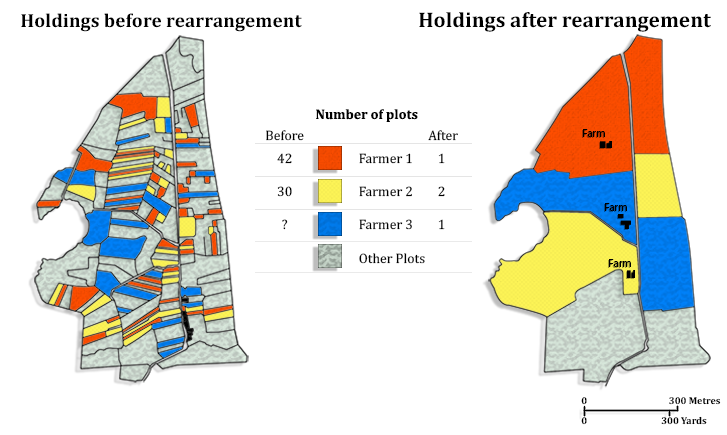👉 Find out about The Open University's Geography courses. 👈
Explore the articles in this collection
-
Change in the West of Ireland
Read now to access more details of Change in the West of IrelandIntroducing a collection of articles asking 'How can unique and distinctive regions, like the West of Ireland, retain the qualities that make them unique while continuing to modernise and interact with the wider world?'

Article
-
Synthesis as a way of understanding the changing uniqueness of rural Ireland
Take part now to access more details of Synthesis as a way of understanding the changing uniqueness of rural IrelandWhat is synthesis? Discover how this way of thinking helps us to understand more about the way in which places retain their uniqueness within wider systems of interdependence.

Activity
-
The West of Ireland: Dimensions of distinctiveness
Read now to access more details of The West of Ireland: Dimensions of distinctivenessHow do you define 'the West of Ireland'? Do you look at cultural factors, geography, or something else?

Article
-
Culture and regional distinctiveness
Read now to access more details of Culture and regional distinctivenessCulture and how language identifies that culture are key to understanding what makes a region unique.

Article
-
The rural dimension – after rundale
Watch now to access more details of The rural dimension – after rundaleHow did the rural areas of Western Ireland change after the rundale system was replaced?

Video
-
A changing uniqueness – The changing ‘place’ of the West
Read now to access more details of A changing uniqueness – The changing ‘place’ of the WestThe population of Western Ireland declined dramatically between 1891 and 1961. How do you think this affected Ireland as a whole?

Article
-
The realities of rural life in the 1950s-1980s
Watch now to access more details of The realities of rural life in the 1950s-1980sThe period of the 1950s to 1980s was the beginning of modernisation in community life and farming and the development of manufacturing industry in the West of Ireland.

Video
-
Culture and the manufacturing industry, 1983
Watch now to access more details of Culture and the manufacturing industry, 1983In 1983, the fight to retain a unique Irish speaking culture meant that jobs had to be created locally in manufacturing and tourism so that Irish speakers no longer had to emigrate, but industrialisation also threatened the survival of the Irish language.

Video
-
The dilemma of tourism and the Irish language, 1983
Watch now to access more details of The dilemma of tourism and the Irish language, 1983Father James McDyer discusses the dilemma of the Glencolmcille holiday village between development, language and culture and the threat of depopulation. Tourism is important for economic development but what impact does it have on local culture and the Irish language?

Video
-
A new layer: Culture, the Irish language and identity in 2015
Watch now to access more details of A new layer: Culture, the Irish language and identity in 2015We revisit the Glencolmcille folk village in 2015 to see whether the dilemma of development and the local language and culture has been resolved.

Video
-
Southwest Donegal: uniqueness and interdependence in 2015
Read now to access more details of Southwest Donegal: uniqueness and interdependence in 2015In Southwest Donegal, we see both the local uniqueness and different interdependencies and interconnections with other places.

Article
-
The future of rural Ireland - nuances, scale and fighting back
Read now to access more details of The future of rural Ireland - nuances, scale and fighting backThe future of rural Ireland - nuances, scale and fighting back

Article
 Rundale clachan patterns of settlement still visible in County Mayo
Agriculture itself represents a synthesis of the social, the environmental and the spatial. A combination of factors within society and environment such as soils and climate, cultural forms, local social organisation and the wider economic and political context, both national and international, are drawn together in change over time.
Rundale clachan patterns of settlement still visible in County Mayo
Agriculture itself represents a synthesis of the social, the environmental and the spatial. A combination of factors within society and environment such as soils and climate, cultural forms, local social organisation and the wider economic and political context, both national and international, are drawn together in change over time.
The present rural landscape in the West of Ireland is a mosaic of small fields, small settlements and small farms. Most of them have been established since the middle and end of the 19th century and exist, not in response to physical factors, but as a result of wider social processes involving landlords, governments and the economic system. There are, of course, small farms all over the world, and in many parts of Europe and Britain as well as all over Ireland. In that sense, what we see in the West of Ireland is part of a widespread distribution of this system of agriculture. It is the process of their establishment in the West of Ireland that is distinctive, representing a clash between the remnants of a particular small-scale peasant society and a specific manifestation of large-scale capitalist society that has seen a progressive disintegration of the old additional systems of landholding, settlement and agricultural practice.
With fertile land limited in extent and uneven in distribution, the Irish rundale (or open field) system had maintained a rural society based on small kin groups living in clustered settlements or ‘clachans.’ Farming land was held jointly and distributed in separate, small pieces. When it functioned successfully, rundale was a finely- balanced ecological system, but it could not function effectively in the face of demands for increased productivity. These demands arose from two main sources. On the one hand, there was the desire of landlords and governments to improve agricultural practice in order to increase production and rents.
On the other hand, population increase, which was closely associated with the nutritional capacity of the potato to form the basis of the diet of the poor, took place despite periodic crop failure through blight and the failure of society at large to prevent that crop failure. In other words, in a wider social context the traditional system could not deliver the economic and social goods.
Rundale had virtually disappeared in the West of Ireland by the 1920s, but some 20 years after that it was still a fact of life in Rathlackan in Northeast Mayo. In an article in the Irish Times in January 1943, the apparently bemused reporter described a historic layer which had only just succumbed to modernisation processes which were well-established elsewhere in the region (Irish Times, 1943).
To feel the impact of the change, try locating and counting the plots held by farmer 3 at Cloondeagh Co Mayo, in rundale and after the rearrangement. (Image source)
 An example of the effects of reorganisation, Clooneagh, County Mayo
An example of the effects of reorganisation, Clooneagh, County Mayo
Reveal answer:
We were able to count 22, or 21 if you count the westernmost area as a single plot.
It is also interesting to see that Jill Dale, writing on genealogy website County Mayo Beginnings, reported rundale being practised in County Mayo into the 1980s, long after the practice was thought to have died out (Dale, 2010) .
Explore the articles in this collection
-
Change in the West of Ireland
Read now to access more details of Change in the West of IrelandIntroducing a collection of articles asking 'How can unique and distinctive regions, like the West of Ireland, retain the qualities that make them unique while continuing to modernise and interact with the wider world?'

Article
-
Synthesis as a way of understanding the changing uniqueness of rural Ireland
Take part now to access more details of Synthesis as a way of understanding the changing uniqueness of rural IrelandWhat is synthesis? Discover how this way of thinking helps us to understand more about the way in which places retain their uniqueness within wider systems of interdependence.

Activity
-
The West of Ireland: Dimensions of distinctiveness
Read now to access more details of The West of Ireland: Dimensions of distinctivenessHow do you define 'the West of Ireland'? Do you look at cultural factors, geography, or something else?

Article
-
Culture and regional distinctiveness
Read now to access more details of Culture and regional distinctivenessCulture and how language identifies that culture are key to understanding what makes a region unique.

Article
-
The rural dimension – after rundale
Watch now to access more details of The rural dimension – after rundaleHow did the rural areas of Western Ireland change after the rundale system was replaced?

Video
-
A changing uniqueness – The changing ‘place’ of the West
Read now to access more details of A changing uniqueness – The changing ‘place’ of the WestThe population of Western Ireland declined dramatically between 1891 and 1961. How do you think this affected Ireland as a whole?

Article
-
The realities of rural life in the 1950s-1980s
Watch now to access more details of The realities of rural life in the 1950s-1980sThe period of the 1950s to 1980s was the beginning of modernisation in community life and farming and the development of manufacturing industry in the West of Ireland.

Video
-
Culture and the manufacturing industry, 1983
Watch now to access more details of Culture and the manufacturing industry, 1983In 1983, the fight to retain a unique Irish speaking culture meant that jobs had to be created locally in manufacturing and tourism so that Irish speakers no longer had to emigrate, but industrialisation also threatened the survival of the Irish language.

Video
-
The dilemma of tourism and the Irish language, 1983
Watch now to access more details of The dilemma of tourism and the Irish language, 1983Father James McDyer discusses the dilemma of the Glencolmcille holiday village between development, language and culture and the threat of depopulation. Tourism is important for economic development but what impact does it have on local culture and the Irish language?

Video
-
A new layer: Culture, the Irish language and identity in 2015
Watch now to access more details of A new layer: Culture, the Irish language and identity in 2015We revisit the Glencolmcille folk village in 2015 to see whether the dilemma of development and the local language and culture has been resolved.

Video
-
Southwest Donegal: uniqueness and interdependence in 2015
Read now to access more details of Southwest Donegal: uniqueness and interdependence in 2015In Southwest Donegal, we see both the local uniqueness and different interdependencies and interconnections with other places.

Article
-
The future of rural Ireland - nuances, scale and fighting back
Read now to access more details of The future of rural Ireland - nuances, scale and fighting backThe future of rural Ireland - nuances, scale and fighting back

Article
Rate and Review
Rate this article
Review this article
Log into OpenLearn to leave reviews and join in the conversation.
Article reviews